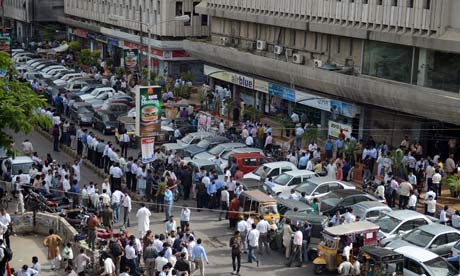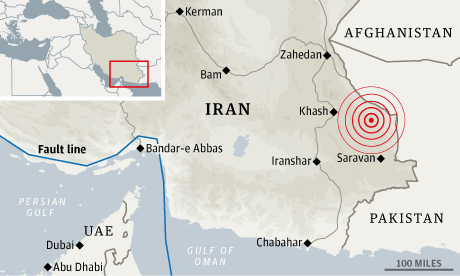Jason Burke in Delhi and Saeed Kamali Dehghan
Guardian.co.uk,

People are evacuated from buildings following tremors in Karachi, after a huge earthquake struck near the Iran-Pakistan border. Photograph: Asif Hassan/AFP/Getty Images
Communications to the region near the epicentre, in a remote corner of the south-east of Iran, appear to be cut off.
Tremors were felt across the Gulf region, across Pakistan and well into north-west India on Tuesday, when the quake happened at 10.44am GMT.
The US Geological Survey said it had measured the earthquake at magnitude 7.8 and gave its location at 50 miles east-south-east of the town of Khash, in Iran. It is the biggest earthquake in Iran for 40 years.
Though the area is largely desert and mountains, there are several major cities, including Zahedan, 125 miles away, which has more than half a million inhabitants.
One Iranian told the Guardian that the small town of Hiduj, which had a population of around 1,000 according to a 2006 census, had been badly damaged.
The Iranian semi-official news agency Fars quoted Tehran University's geophysics centre as saying the quake had hit the south-eastern city of Saravan in Sistan and Baluchistan province, at 3.14pm local time and reported that it had killed at least 40 people, according to some of their sources. At least seven villages near the city had been affected, the agency said.
But Fars also quoted Fariborz Rashedi, the head of medical emergencies for Sistan and Baluchistan, as saying the situation in his province was "normal", with only three people injured.
On the Pakistan side, the situation seemed just as confused. "We have reports of three deaths near the Pakistan-Iran border in MashKhel area of Panjgore district," said a local government official, requesting anonymity.
The official added that around 40 people had been injured when wooden roofs and mud walls collapsed. The sparsely populated district is one of Pakistan's most underdeveloped, with minimal telecommunication and infrastructure.
There is no official announcement of a death toll by Pakistan's disaster management authority. However, a police officer in the Kalat district, near the provincial capital of Quetta, said they are assessing the damage in towns along to the Iranian border.

Iran earthquake location. Graphic: The Guardian
There are reports of panic in Karachi where residential buildings and government offices have developed cracks.Saleh Mangi, from the NGO Plan International, said he was in a meeting with staff in their office in Thatta, around 65 miles from the port city, when they felt the ground shake. "It was horrible – we felt the movement in the chairs and even the cupboards were shaking. This is the strongest quake I have felt since the 1980s. And this is an area prone to earthquakes and cyclones."
"We sounded our emergency alarm and emergency alarms were going off in the houses around us. Everyone was pouring out of their homes and offices. People were afraid and didn't know what was happening. People are afraid to go back to their homes and the government is telling fishing communities [on the coast] not to go into the sea as that would be very dangerous."
Close to 8 magnitude means an extremely powerful quake, on a level with the one that killed an estimated 68,000 people in Sichuan province, China, in 2008.
An Iranian citizen in the southern city of Shiraz, about 650 miles from the epicentre, said the quake was felt there.
There was concern that facilities associated with Iran's controversial nuclear programme might have been affected.
A witness in Saravan told BBC's Persian service: "The earthquake was felt gravely across the city and the old part of the city as well as its main sport centre have been destroyed but thanks God because it could be worse."
Ahmad-Reza Shajiee, the deputy head of Iran's Red Crescent, told the state Irna news agency that there was a complicated emergency situation in affected areas in Sistan and Baluchistan.
"Soon after we received the news about the quake, a crisis meeting was held and a group of rescuers from the Red Crescent society were dispatched to Sistan and Baluchistan province," he said.
But the Bushehr nuclear power plant was not damaged, said an official at the Russian firm that built the plant. The official at Atomstroyexport, who spoke on condition of anonymity, said he had spoken to a colleague at the plant after the quake and that no damage was reported.
Bushehr, Iran's sole nuclear power plant, is near the Gulf coast in western Iran. There was no immediate independent confirmation of his statement.
In Delhi, India, more than 1,500 miles from the suspected epicentre, office workers evacuated buildings as fittings shook and windows rattled. Tremors lasted for around 30 seconds.
"It was very frightening. Everything started moving. I ran into the street," said Ghautam Menon, an office worker in the south of the Indian capital.
In 2003, a major quake near the Iranian city of Bam, not far from Tuesday's epicentre, killed 30,000.
Iran experiences earthquakes frequently. A week ago, a 6.1-magnitude quake hit near Bushehr, on the Persian Gulf coast, killing at least 37 people.
http://www.guardian.co.uk/world/2013/apr/16/earthquake-hits-iran-pakistan-border

No comments:
Post a Comment